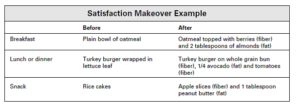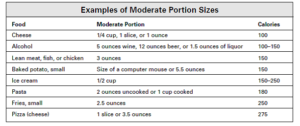1.Your Goal: Embrace All Foods
- Remind yourself that no single food causes weight gain. Weight management is based on total calories and not on restricting certain foods or food groups.
- Instead of thinking about foods as being just “good” or “bad,” change your food language.
Word Choices When Talking About Food
Instead of saying “This is a bad food,” say “This food has a lot of calories; if I really want it, I will eat it in moderation.”
Instead of saying “I cheated,” say “I ate more than I wanted to, but that happens to everyone once in a while. It is normal and I won’t beat myself up over it.”
Instead of saying “I was bad,” say “I ate more calories than I intended, but I am in control now.”
Instead of saying “I feel so guilty,” say “I did nothing wrong. I ate a moderate portion of something I wanted to eat and I enjoyed every bite.”
Practice meal and snack makeovers to increase satisfaction.


2.Your Goal: Add Fiber and Healthy Fats for More Eating Pleasure
- Add fiber-rich foods to your meals and snacks to increase your sensation of fullness.
- Make meals taste better by using moderate amounts of healthy fats, such as nuts, avocado, olives, and oils that are liquid at room temperature (such as grape seed, canola, sesame, peanut, olive, and safflower oil)
- Practice meal and snack makeovers to increase satisfaction.
Aim to have about 5 teaspoons of healthy fat per day (1 tablespoon liquid oil or 1/2 avocado, or 1 ounce of nuts or seeds = 3 teaspoons fat; 8 olives = 1 teaspoon fat; 2 tablespoons peanut butter = 4 teaspoons fat; 2 tablespoons vinaigrette-type salad dressing = 2 teaspoons fat).

3.Your Goal: Enjoy Once Off-Limit Foods in Smaller Portions
- Slowly incorporate foods you once considered “bad” into your eating plan:
Don’t be discouraged if you occasionally eat too much of a food that was once “off limits.” If you are used to eating large quantities of a food, it may take practice to moderate your portions.
Purchase portion-controlled packs of your “off-limit” foods to help control portions.
- Savor every bite and take your time:
Make snacks last at least 15 minutes and meals last at least 30 minutes.
Instead of eating quickly out of packages, make food special by putting it on a real plate or bowl and using silverware.
- Limit distractions and enjoy your food without watching television.
4.Your Goal: Socialize and Enjoy
- Enjoy once “off-limit” foods in the company of others. This may help you avoid overindulging when you are alone.
- When you are in a restaurant with companions, order what you want, not what you “should” eat:
Savor every bite and enjoy it slowly.
Stop eating when you feel the first signs of fullness. Don’t feel that you must clean your plate.
- If you have difficulty eating certain foods in small amounts when home alone, practice eating “safe portions” in “safe places” (places where you’re less likely to overeat).

Safe Portions, Safe Places Examples
Instead of buying a 1/2-gallon carton of ice cream, have a scoop of ice cream with your friends at a restaurant or eat a one scoop cone from an ice cream shop.
Instead of buying a large bag of chips for home, have chips on the side of your sandwich the next time you go out for lunch.
Instead of buying a bag of cookies for your home, buy one cookie and eat it at a coffee or pastry shop while sipping coffee or tea.
Instead of ordering a whole pizza, have a slice with friends at a restaurant.




Leave a Comment